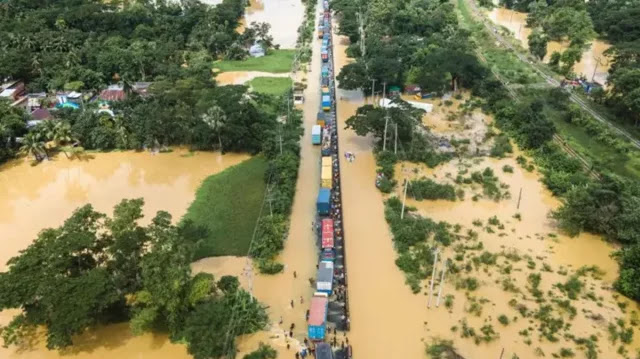The prediction that natural disasters will increase by 40 percent by 2030 is alarming and underscores the urgent need for global action to mitigate and adapt to the growing risks posed by climate change and environmental degradation. Here are some key factors contributing to this projected increase, along with potential consequences and strategies to address the challenge:
### **1. Climate Change**
- **Rising Temperatures:** Global warming is causing temperatures to rise, leading to more frequent and severe heatwaves, droughts, and wildfires. Warmer temperatures also contribute to the melting of polar ice and glaciers, which can lead to rising sea levels and increased flooding.
- **Extreme Weather Events:** Climate change is associated with an increase in the frequency and intensity of extreme weather events, such as hurricanes, typhoons, and cyclones. These storms are becoming more powerful due to warmer ocean temperatures, which provide the energy needed for their formation.
- **Changing Precipitation Patterns:** Shifts in precipitation patterns, including more intense and unpredictable rainfall, can lead to both severe flooding and prolonged droughts in different regions, further exacerbating the risk of natural disasters.
### **2. Environmental Degradation**
- **Deforestation:** The loss of forests due to logging, agriculture, and urban expansion reduces the land's ability to absorb rainfall, increasing the likelihood of floods and landslides.
- **Soil Erosion and Desertification:** Unsustainable land use practices, such as overgrazing and poor agricultural practices, contribute to soil erosion and desertification, making lands more vulnerable to droughts and reducing agricultural productivity.
- **Loss of Biodiversity:** The destruction of ecosystems and loss of biodiversity can weaken natural defenses against disasters, such as mangroves that protect coastal areas from storm surges and coral reefs that act as barriers against waves.
### **3. Urbanization and Population Growth**
- **Increased Vulnerability:** Rapid urbanization, especially in developing countries, often leads to the expansion of cities into areas prone to natural disasters, such as floodplains, coastal regions, and earthquake zones. This increases the number of people and assets at risk.
- **Inadequate Infrastructure:** Many urban areas, particularly in low-income countries, have inadequate infrastructure to cope with natural disasters. Poorly constructed buildings, lack of drainage systems, and insufficient emergency services can exacerbate the impact of disasters.
### **4. Socioeconomic Factors**
- **Poverty and Inequality:** Communities with limited resources are more vulnerable to natural disasters because they lack the means to prepare for, respond to, and recover from such events. Poverty, inequality, and lack of access to education and healthcare can all increase disaster risk.
- **Population Displacement:** As natural disasters become more frequent and severe, the number of people displaced by these events is likely to increase, leading to humanitarian crises and strain on resources in affected and neighboring regions.
### **5. Consequences of Increased Natural Disasters**
- **Humanitarian Crises:** An increase in natural disasters could lead to more frequent humanitarian crises, with higher numbers of casualties, injuries, and displaced persons. This would put a significant strain on global humanitarian response systems.
- **Economic Losses:** The economic impact of natural disasters can be devastating, with the destruction of infrastructure, homes, and businesses. Repeated disasters can hamper economic growth, especially in vulnerable regions, and increase the burden of recovery and reconstruction.
- **Environmental Impact:** Repeated natural disasters can cause long-term environmental damage, including loss of ecosystems, soil degradation, and pollution, further exacerbating the effects of climate change.
### **6. Strategies to Address the Challenge**
- **Mitigation Efforts:** Reducing greenhouse gas emissions is critical to slowing the pace of climate change. This requires a global commitment to transitioning to renewable energy sources, improving energy efficiency, and protecting and restoring forests and other natural carbon sinks.
- **Adaptation and Resilience:** Building resilience to natural disasters involves investing in infrastructure that can withstand extreme weather, improving early warning systems, and developing comprehensive disaster preparedness plans. Communities must be empowered with the resources and knowledge to adapt to changing conditions.
- **Sustainable Development:** Promoting sustainable land use practices, protecting ecosystems, and ensuring that development is environmentally responsible can reduce vulnerability to natural disasters. Urban planning should take disaster risk into account to prevent building in high-risk areas.
- **International Cooperation:** Addressing the global challenge of increasing natural disasters requires international collaboration. Countries must work together to share knowledge, technology, and resources to build global resilience and respond effectively to disasters.
### **Conclusion**
The projected 40 percent increase in natural disasters by 2030 is a stark warning that the world must take immediate and concerted action to mitigate climate change and adapt to its impacts. This includes reducing emissions, protecting the environment, and building resilience in vulnerable communities. The consequences of inaction are severe, with potential humanitarian, economic, and environmental crises on the horizon. However, with global cooperation and sustainable development practices, it is possible to reduce the risks and protect future generations from the worst effects of natural disasters.










